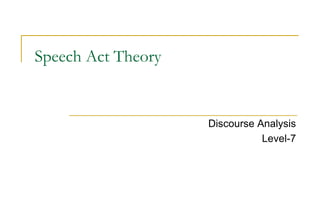Speech act theory
•Télécharger en tant que PPTX, PDF•
2 j'aime•6,183 vues
Linguistics
Signaler
Partager
Signaler
Partager

Recommandé
Contenu connexe
Tendances
Tendances (20)
Similaire à Speech act theory
Similaire à Speech act theory (20)
eng_429_-_chapter_3_-_discourse_and_pragmatics.pdf

eng_429_-_chapter_3_-_discourse_and_pragmatics.pdf
Communicative competence strategies in various speech situations

Communicative competence strategies in various speech situations
Oral-Communication_Unit-6_Lesson-3_Illocution-1 (2).pptx

Oral-Communication_Unit-6_Lesson-3_Illocution-1 (2).pptx
Plus de Dr. Mohsin Khan
Plus de Dr. Mohsin Khan (20)
Dernier
God is a creative God Gen 1:1. All that He created was “good”, could also be translated “beautiful”. God created man in His own image Gen 1:27. Maths helps us discover the beauty that God has created in His world and, in turn, create beautiful designs to serve and enrich the lives of others.
Explore beautiful and ugly buildings. Mathematics helps us create beautiful d...

Explore beautiful and ugly buildings. Mathematics helps us create beautiful d...christianmathematics
Dernier (20)
Kisan Call Centre - To harness potential of ICT in Agriculture by answer farm...

Kisan Call Centre - To harness potential of ICT in Agriculture by answer farm...
Z Score,T Score, Percential Rank and Box Plot Graph

Z Score,T Score, Percential Rank and Box Plot Graph
9548086042 for call girls in Indira Nagar with room service

9548086042 for call girls in Indira Nagar with room service
Explore beautiful and ugly buildings. Mathematics helps us create beautiful d...

Explore beautiful and ugly buildings. Mathematics helps us create beautiful d...
social pharmacy d-pharm 1st year by Pragati K. Mahajan

social pharmacy d-pharm 1st year by Pragati K. Mahajan
Beyond the EU: DORA and NIS 2 Directive's Global Impact

Beyond the EU: DORA and NIS 2 Directive's Global Impact
Ecosystem Interactions Class Discussion Presentation in Blue Green Lined Styl...

Ecosystem Interactions Class Discussion Presentation in Blue Green Lined Styl...
Speech act theory
- 1. Speech Act Theory Discourse Analysis Level-7
- 2. Introduction This concept was proposed by John Langshaw Austin in 1962 one of the founders of pragmatics and later developed by John R. Searle in 1969, both philosophers of language, they believe that language is not only used to inform or to describe things, it is often used “to do things”, to perform acts. In other words actions performed via utterances are generally called speech acts. Speech Acts are group of utterances with a single interactional function.
- 3. Austin’s Statement Effect / per locution Desire/ Illocution Specific words locution Austin distinguished three acts in one single speech act or event we perform. 1) locution = physical utterance by the speaker 2) illocution = the intended meaning of the utterance by the speaker (performative) 3) perlocution = the action that results from the locution Example, Alice told Tom: "Would you please close the door“
- 4. Illocutionary act Illocutionary acts are the real actions which are performed by the utterance. We form an utterance with some kind of function in mind. This communicative force of an utterance is known as illocutionary force. (Intention/desire of the speaker) Example; I am not feeling well. I want to rest now (Intention)
- 5. Locutionary act Locutionary act is the basic act of utterance, or producing a meaningful linguistic expressions. We can say performing an act of saying something or physical utterances of words. Example; I am not feeling well. ( Linguistic meaning)
- 6. Perlocutionary act Perlocutionary act is the effect/ result produced on the listener when they listen a locutionary act or this is the hearers response. Response may be negative or positive. Example; I am not feeling well. ( Linguistic meaning) Locutionary I want to rest now (Intention) Illocutionary Yes Sir, you may take the class next week. (result) Perlocutionary
- 7. This theory was further classified by John Searle. He states that the taxonomy used by Austin is defective, especially there is a lack of clear criteria for distinguishing one kind of illocutionary force from another. Searle divides illocutionary acts into five basic types. 1. Directive 2. Commissive 3. Representative/Assertive 4. Declarative 5. Expressive
- 8. 1. Directive In the conversation between 1st and 2nd person here the speaker tries to make the hearer do something, with words as: ask, order, command, request, beg, plead, pray, entreat, invite, permit, advise, demand etc. Example; Give me your pen. Leave the town immediately.
- 9. 2. Commissive Here the speaker commits himself or herself to the future course of action, with verbs such as: guarantee, promise, swear, refuse, threating etc. Examples; I will repay the money. I swear to tell the truth.
- 10. 3. Representative/Assertive Here the speaker asserts a proposition to be true, using such verbs as: affirm, believe, conclude, deny, report, state. Etc. Examples The earth is round. I think, he is saying the truth.
- 11. 4. Declarative Here the speaker alters the external status or condition of an object, situation or context solely by making the utterance. Examples; Class dismissed. You are fired. We find defendant not guilty.
- 12. 5. Expressive Here the speaker expresses an attitude to or about a state of affairs, using such verbs as: thanks, congratulate, apologize, praise etc. Examples; I am sorry for being late. What a great day! Congratulation!
- 13. Example A bartender utters the words, "The bar will be closed in five minutes”. The locutionary act of saying that the bar will be closed in five minutes, where what is said is reported by indirect quotation. The illocutionary act in saying this, the bartender is informing the patrons of the bar's imminent closing and perhaps also the act of urging them to order a last drink. The bartender intends to be performing the perlocutionary acts of causing the patrons to believe that the bar is about to close and of getting them to order one last drink.
